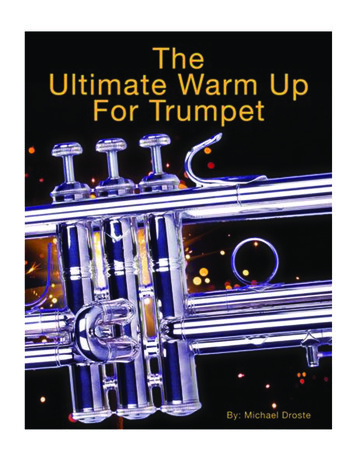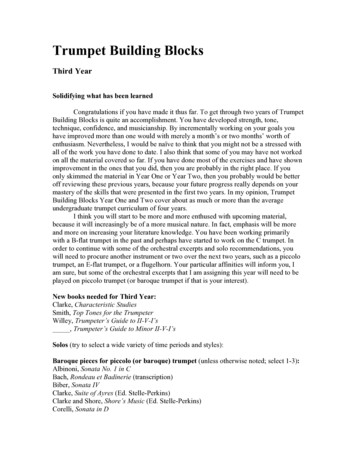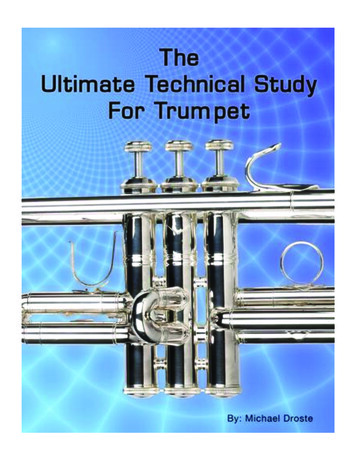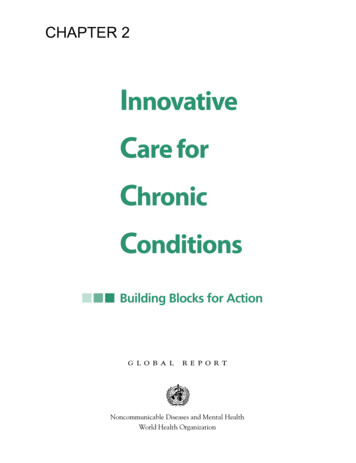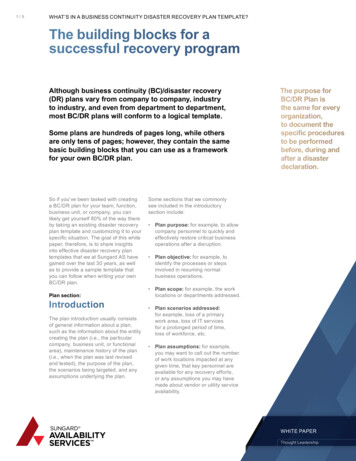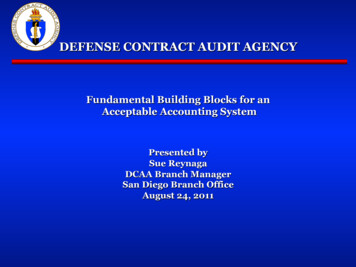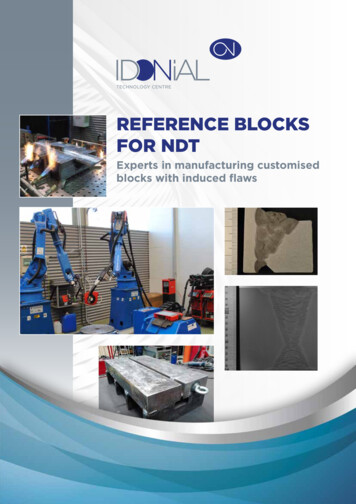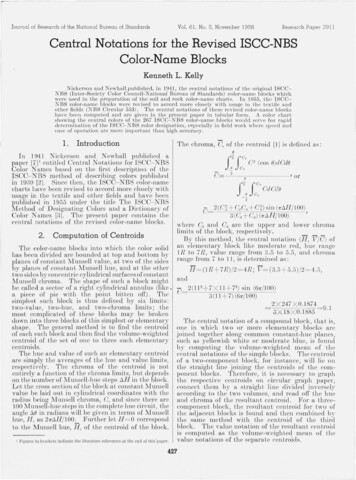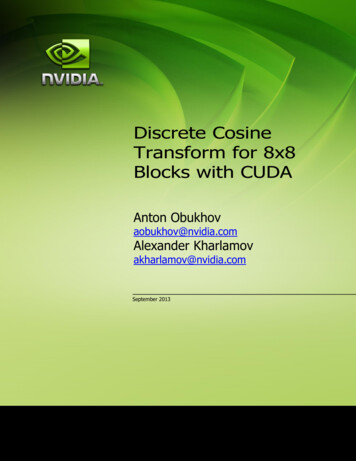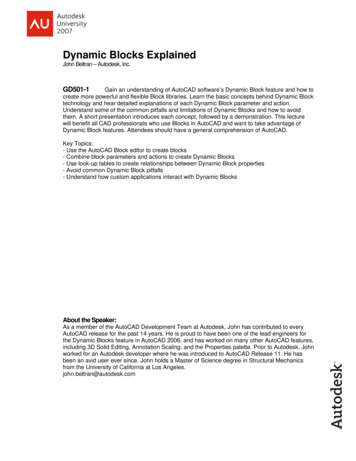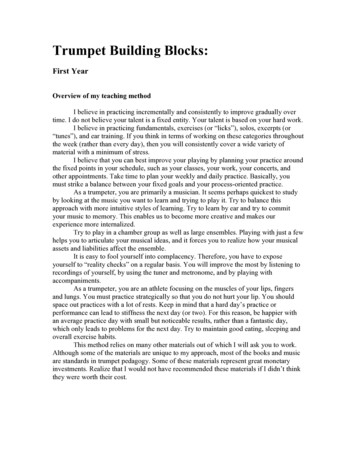
Transcription
Trumpet Building Blocks:First YearOverview of my teaching methodI believe in practicing incrementally and consistently to improve gradually overtime. I do not believe your talent is a fixed entity. Your talent is based on your hard work.I believe in practicing fundamentals, exercises (or “licks”), solos, excerpts (or“tunes”), and ear training. If you think in terms of working on these categories throughoutthe week (rather than every day), then you will consistently cover a wide variety ofmaterial with a minimum of stress.I believe that you can best improve your playing by planning your practice aroundthe fixed points in your schedule, such as your classes, your work, your concerts, andother appointments. Take time to plan your weekly and daily practice. Basically, youmust strike a balance between your fixed goals and your process-oriented practice.As a trumpeter, you are primarily a musician. It seems perhaps quickest to studyby looking at the music you want to learn and trying to play it. Try to balance thisapproach with more intuitive styles of learning. Try to learn by ear and try to commityour music to memory. This enables us to become more creative and makes ourexperience more internalized.Try to play in a chamber group as well as large ensembles. Playing with just a fewhelps you to articulate your musical ideas, and it forces you to realize how your musicalassets and liabilities affect the ensemble.It is easy to fool yourself into complacency. Therefore, you have to exposeyourself to “reality checks” on a regular basis. You will improve the most by listening torecordings of yourself, by using the tuner and metronome, and by playing withaccompaniments.As a trumpeter, you are an athlete focusing on the muscles of your lips, fingersand lungs. You must practice strategically so that you do not hurt your lip. You shouldspace out practices with a lot of rests. Keep in mind that a hard day’s practice orperformance can lead to stiffness the next day (or two). For this reason, be happier withan average practice day with small but noticeable results, rather than a fantastic day,which only leads to problems for the next day. Try to maintain good eating, sleeping andoverall exercise habits.This method relies on many other materials out of which I will ask you to work.Although some of the materials are unique to my approach, most of the books and musicare standards in trumpet pedagogy. Some of these materials represent great monetaryinvestments. Realize that I would not have recommended these materials if I didn’t thinkthey were worth their cost.
Equipment:Trumpets—you’ll need a good B-flat trumpet, such as by Bach, Yamaha, Monette,Schilke, Conn, Kanstul, etc.Mouthpieces—I recommend a medium to large size mouthpiece (such as a Bach 1-5C;the following manufacturers are a representative (but not exclusive) list of goodmouthpiece makers. I recommend that you study mouthpiece comparison charts found atmany websites (such as the “Kanstul Mouthpiece Comparator”—www.kanstul.net/mpcJN/all mouthpieces.shtml):Warburton; Yamaha; GR Mouthpieces; Hammond; Greg Black; Laskey; Stork; Kanstul;and many more. A great reference for mouthpiece design and selection is DavidHickman’s Trumpet Pedagogy.Accessories—you’ll need a metronome, a tuner, a good recording device, a computer“studio”—where you can practice with recordings and other types of accompaniments.Study materials (* denotes a priority):Methods:*Jean-Baptiste Arban, Complete Conservatory Method for Trumpet*Claude Gordon, Systematic Approach to Daily Practice*Herbert L. Clarke, Technical Studies*Clarke, Setting Up Drills*Bai Lin, Lip Flexibilities*James Thompson, The Buzzing BookMax Schlossberg, Daily Drills and Technical Studies for TrumpetJames Stamp, Warm-Ups StudiesEtudes*N. Bousquet, 36 Celebrated Studies*Brandt, Orchestral Etudes*Small, 27 Melodious and Rhythmic Exercises*Bordogni, The Complete Book of Vocalises (many different editions)Concone, Vocalises (many different editions)Getchell, First and Second Books (for beginning work on transposition)V. Berdiev, 17 Studies for TrumpetOrchestral and/or jazz studies*P. Norris, Top 50 Orchestral Excerpts (Crown Music Press)Rob Roy McGregor, Audition and Performance Preparation for Performance;Orchestral Literature Studies, Volume I*Rich Willey, Jazz Improv Materials Handbook Complete (great for trumpeters even ifyou’re not seriously pursuing jazz), Trumpeter’s Guide to II-V-I’s in Twelve Keys, Trumpeter’s Guide to Minor II-V-I’s in Twelve KeysDavid Baker, How to Play Bebop, vols. 1-3Solos (try to select a wide variety of time periods and styles):Baroque pieces
Transcriptions (for B-flat Trumpet):Corelli/Fitzgerald, Sonata VIIIFitzgerald, Bach SuiteTelemann/Paetzold, Heroic MusicVivaldi/Fitzgerald, AllegroOriginal Pieces for Baroque Trumpet (playable on piccolo—or C, D, or Gtrumpets):Albinoni, Sonata No. 1 in CClarke, “Suite of Ayres” (publ. McNaughtan)Clarke/Shore, “Shore’s Musick” (McNaughtan)Fantini, any of his various sonatas (these might be playable on C trumpet)Krebs, Six Chorale Preludes (some are playable on C trumpet—others are only forpiccolo in the high register)Telemann, Air de TrompettePurcell, SonataTorelli, Sonata in D (the so-called “Etienne Roger”—requires piccolo)Viviani, Sonata 1 or 2 (these might be playable on C trumpet)Two of the following short pieces:Anderson, A Trumpeter’s LullabyBalay, Petite Piece ConcertanteBarat, OrientalBarat, Andante et ScherzoBarat, Fanaisie en Mi-flatBerdiev, ElegyBernstein, Rondo for LifeyBerghmans, La ChenilleBloch, ProclamationBoehme, Berceuse, Op. 7Bozza, BadinageBroughton, FolksongBernstein, Rondo for LifeyEwazen, Ballade for a CeremonyEwazen, Prayer and PraiseGabaye, BoutadeGabaye, Feu d’ArtificeHartley, SonatinaHovhanness, Prayer of St. GregoryLatham, SuitePersichetti, The HollowmenPlog, Animal Ditties I and II (need narrator)Ravel, Piece en forme de HabaneraRopartz, Andante et AllegroStarer, Invocation
Turrin, Four MiniaturesTurrin, Three EpisodesRomantic Trumpet LiteratureAny Arban pieceKail, Variations in FKreutzer, VariationsWeber, F. D. Variations in FOne of these concerti:Fitzgerald, ConcertoGiannini, ConcertoHaydn, Concerto in E-flatNeruda, Concerto in E-flat (originally for horn)Riisager, ConcertinoSonatas:Berdiev, SonataPeeters, SonataEmmanuel, SonataHansen, Sonata for cornet and pianoKennan, SonataPilss, Sonata“Show stoppers” or encore pieces:Llewellyn, My RegardsAn Arban cornet solo—be ready for some triple tonguingGoedicke, Concert EtudeA Clarke cornet solo, such as Maid of the Mist, Trixie Valse, Venus Waltz, or VictoryUnaccompanied pieces:Arnold, FantasyBowles, Night Sun Journey (with CD)Presser, Second Suite
OrganizationThis book is organized into three main periods: two academic semesters and avacation. Each semester has 14 weeks. The vacation, or summer, practice is presented atthe end of this book as a cyclical, rather than a weekly, practice plan. The semestermaterial is presented in weekly grids. Each week is broken down into six practice dayswith one day leftover each week to do something different (this could very well includerest!). These six days should be arranged to suit the student’s schedule. A “block”represents each element of practice. This grid is merely a suggestion. Considerrearranging the material from scratch according to your own preferences.By the end of each semester, the academic term, and the whole year, the studentwill have achieved demonstrable improvement in fundamentals, basic musicalvocabulary, ear training, and musical literature.These studies will gradually increase the student’s fundamental abilities in theseareas: strength, range, tone, finger dexterity, articulation (single, double, and more), lipflexibility, accuracy, and air control. I have taken great care to identify these graduallyincreasing goals, so that the student will make a little improvement each week but willnot burn out from muscle fatigue.This book will lay out basic musical material for improvement in rhythm, melodicmaterial, transposition, jazz vocabulary, and sight-reading.This book will demand ear-training exercises of the student. They might be fromone of David Lucas Burge’s courses or some transcription of a live recording (perhapsmade easier by Transcribe! software (or some other software that can slow down an audiotrack while maintaining the pitch level).This book will help the student increase his or her musicality by assigningappropriate vocalises, etudes, jazz tunes, orchestral excerpts, and solo pieces. The list ofsuggestions is limited to what I consider the core repertoire of a classically-trainedtrumpeter. These are the building blocks of a common musical language of mosttrumpeters the world over who play in orchestras or bands or who are in academia. Feelfree to make substitutions of this literature based on your particular interests, availability,and the opinion of your teacher.Goals for the Undergraduate Student upon completion of four years1. Tune impeccably2. Play with a focused, warm, clear tone3. Expand range to at least a high F above high C4. Single Tongue to mm. 1165. Double Tongue to mm. 1606. Triple Tongue to mm. 1107. Be able to lip trill8. Have overall good lip flexibility9. Be able to transpose from B-flat trumpet and C trumpet to the most commonly usedkeys
Master about 80 etudes; 25 orchestral excerpts; and 80 jazz or Renaissanceimprovisational patternsMemorize 5 etudes, 8 solos, 16 orchestral excerpts, and 4 jazz transcriptionsRelative Pitch firmly in placePerfect Pitch attemptedDevelop four recitals worth of music (about 20 solos)About 2 sonatasAbout 4 concertosAbout 8 short character types of pieces4 “show stoppers”1 unaccompanied pieceDevelop an understanding of the “soft zone” and how to trigger itYear One, First SemesterGoals for the First Semester1. Work on 5 Gordon long tone routines with tuner2. Buzzing exercises as assigned3. Single tongue up to 884. Double tongue up to 1204. Triple tongue up to 805. Lip Flexibilities and lip trill basics6. Master 10 etudes; 5 solo piece movements; 8 orchestral excerpts; 10 jazz “licks”; 51Arban “Art of Phrasing” vocalises7. Clarke Technical Studies, groups 1-4
8. Once through the Rich Willey Jazz Improv Materials book to page 55 (1 key a weekfor 12 weeks)9. Relative Pitch course—Level 110. Perfect Pitch course—Masterclasses 1 to 5Week 1Plan your week according to these suggestions: each block represents a practice session(ideally work on only one block of any particular task per day). On days with lightrehearsal schedules, practice more. On days with heavy obligations, practice less. Thegrid below is merely an example of the minimum I ask you to do.I will give you a CD at the beginning of the semester. This CD has some of my material(mainly some click tracks at various metronome marks) and some material from JamesThompson’s The Buzzing Book CD for B-flat trumpet. You must make sure you alreadyown this book CD, because I do not wish to infringe upon copyright material, nor do Iwish you do to this either.Assignments:Long Tones/MouthpieceGordon, week 1 (Just the 2 long tone routines; 3 blocks—abbreviated “CG”)Mouthpiece Practice CD up to track 8 (3 blocks—“MP”)Minute Drill, single tongue, 16th notes at quarter 75 (6 blocks—“MD” and ST”)TechnicalClarke Technical, Group 1 (2 blocks—“CT”)Arban, interval study (Int), p. 125, triple tongue (TT), p. 155, no. 1-5; double tongue(DT), p. 175, no. 77-81; Art of Phrasing (Ph) p. 191, no. 1-3; CharacteristicStudies (CS) 1, p. 285, 1st four lines. (2 blocks—“A”)Willey, p. 1 (all twelve intervals) (3 blocks—“W”)Technical LitertatureEtude: Bousquet, Etude 1 (2 blocks—“E” for etude)Orchestral excerpt: Beethoven Leonore # 3 call (2 blocks—“O” for orchestral excerpt;see Optional Weekly Excerpt Practice Schedule at the end of this book)Jazz “licks”: practice this ii V7 pattern in all 12 keys (2 blocks—“L” for licks)LiteratureSolo of choice (5 blocks—“S”)Ear TrainingRelative Pitch, Level 1, lesson 1 (5 blocks—“R”)Perfect Pitch, Masterclass 1 (1 blocks—“P”)
Assignment Grid for Week 1 by days of the week: on the first instance of an assignmentin this grid, and subsequent ones, I have written the short-hand version of the specificexercise, so that you can focus primarily on the grid in your practice session, and notalways be looking back and forth between the grid and the written-out assignments.(Always feel free to rearrange these days in this and future assignments to suit your ownweekly needs).Day 1Long TonesCG1MDST75TechnicalCT1Day 2MPSTDay 3Day 4Day 5Day 6CGMPCGMPSTSTSTSTA (Int125,TT155#1-5,DT175:#7781, Ph1-3)WCTWA(CS1:lines14), WTech RDay 7Here is the Mouthpiece Practice CD Track Order, for reference:Track # Track NameTimeArtist1Demo Ex. 1 (Mpc)0:06James Thompson2Exercise 1 (Mpc)0:55James Thompson3voice prompt 750:09Stanley Curtis4751:08Stanley Curtis5Demo Ex. 2 (Mpc)0:14James Thompson6Exercise 2 (Mpc)2:15James Thompson7voice prompt 800:08Stanley Curtis8801:16Stanley Curtis9Demo Ex. 3 (Mpc)0:09James Thompson10Exercise 3 (Mpc)1:42James Thompson11voice prompt 850:07Stanley Curtis
12851:12Stanley Curtis13Demo Ex. 4 (Mpc)0:09James Thompson14Exercise 4 (Mpc)1:38James Thompson15voice prompt 900:07Stanley Curtis16901:19Stanley Curtis17Demo Ex. 5 (Mpc)0:09James Thompson18Exercise 5 (Mpc)1:42James Thompson19voice prompt stamp10:08Stanley Curtis20Stamp12:19Stanley Curtis21Demo Ex. 6 (Mpc)0:10James Thompson22Exercise 6 (Mpc)1:42James Thompson23voice prompt 950:07Stanley Curtis24951:23Stanley Curtis25Demo Ex. 7 (Mpc)0:10James Thompson26Exercise 7 (Mpc)1:42James Thompson27voice prompt 1000:07Stanley Curtis281001:19Stanley Curtis29Demo Ex. 8 (Mpc)0:10James Thompson30Exercise 8 (Mpc)1:42James Thompson31voice prompt stamp20:08Stanley Curtis32Stamp22:24Stanley Curtis33Demo Ex. 9 (Mpc)0:09James Thompson34Exercise 9 (Mpc)2:42James Thompson35voice prompt 1050:07Stanley Curtis361051:15Stanley Curtis37D
Trumpet Building Blocks: First Year Overview of my teaching method I believe in practicing incrementally and consistently to improve gradually over time. I do not believe your talent is a fixed entity. Your talent is based on your hard work. I believe in practicing fundamentals, exercises (or “licks”), solos, excerpts (or “tunes”), and ear training. If you think in terms of working on .
